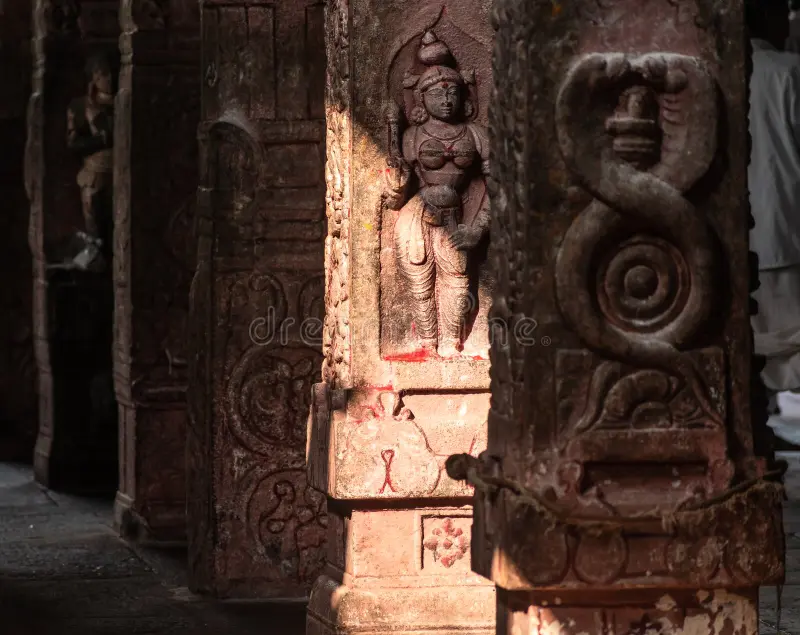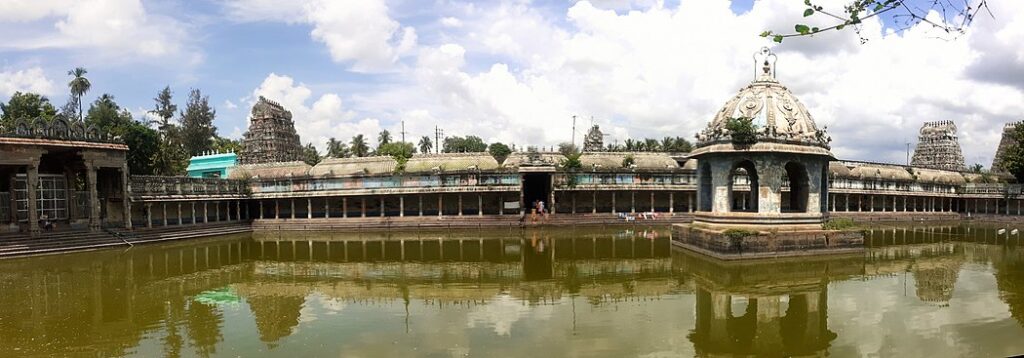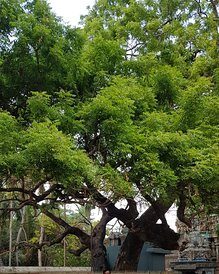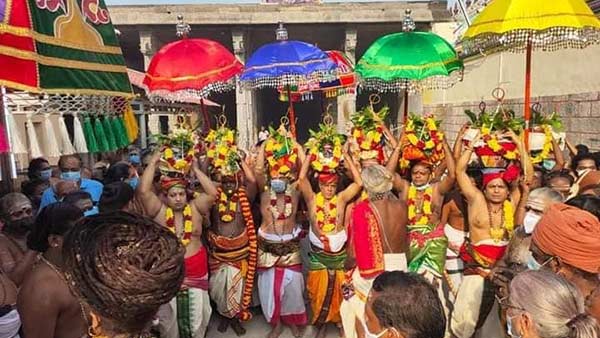Architectural Splendor

The architectural marvel of Vaitheeswaran Temple, nestled 13 kilometers from Mayavaram and 90 kilometers from Thanjavur along the Thanjavur-Chidambaram highway, is a testament to the rich heritage of South Indian temple architecture. This sacred edifice is not only renowned for its curative powers but also for its intricate and awe-inspiring design.
There are a few stone inscriptions of note in this temple and eight of such inscriptions relate to the period of the later Chola kings of Tanjore and the early Maharatta kings.Tirujnana Sambandar, Tirunavukkarasu, Arunagirinathar, Vaduganta Desikar, Sivajnana Desikar, Kumaraguruparaswami, Padikkasu. Tambiran, Chidambara Muni, etc., are the well-known saints who visited and sang in praise of this shrine in the past.
The temple complex is adorned with a five-tiered gopuram, a towering temple tower that welcomes pilgrims into its spiritual embrace. As devotees approach, they are greeted by two inner gopurams that lead the way to the heart of the temple. These towering structures are adorned with intricate sculptures and intricate carvings, showcasing the artistry of the ancient craftsmen who dedicated their skills to the divine.
At the center of this architectural marvel lies the sanctum sanctorum, home to the presiding deity, Lord Vaitheeswaran, who is enshrined as a lingam. The innermost precinct surrounding the sanctum is adorned with various sacred images, including that of Subramanya, revered here as Muthukumara Swamy. These metal images and stone sculptures, depicting deities such as Nataraja, Somaskanda, Angaraka (Mars), and the divine mother Durga, add to the temple’s spiritual ambiance and cultural significance.
One of the most revered areas within the temple complex is the shrine of Thaiyalnayaki, located in the second precinct and facing south. Here, an image of Thiyalnayagi stands in a dignified posture, holding medicinal oil, which is believed to possess curative properties to heal diseases. The temple’s vast precinct also houses a small shrine dedicated to Dhanvantari, the god of medicine, emphasizing the temple’s association with healing practices.
The southern gateway from this precinct leads to the temple tank, a serene and sacred water body. This gateway directly faces the Thaiyalnayaki shrine, allowing devotees to bask in the spiritual energy and healing vibrations that permeate the temple surroundings. Additionally, the temple’s eastern gateway hosts the shrine of the original temple (Adi temple), which features a smaller replica of the primary shrines.

One cannot help but notice the magnificent margosa tree (Azadirachta indica), also known as the neem tree, situated near the eastern gateway. This Sthala Vriksha (temple tree) is believed to possess medicinal properties, further reinforcing the temple’s connection to healing and well-being.
Notably, the temple complex accommodates a shrine dedicated to Angaragan, the god of Mars, located near the eastern gateway within the third precinct. This shrine is of particular significance for those seeking remedies for Mars-related doshas, such as Kuja dosha, and is an essential part of the temple’s healing tradition.
This temple has extensive landed properties including 1176 acres of dry lands and 6105 of wet lands. Jewels to the value of Rs. 1,60,750 are kept here to adorn the deities during festival days, and in recent years many additions like silver and gold cover for the, images, gem-set crown, etc., have been added to the collections by the devotees and the head of the Dharmapuri Adheenam. There is a big car to take the image in procession during the Chitra festival and it was recently constructed at a cost of Rs. 12000/-. Many silver and gold trays have also been endowed by the rich devotees and are used during the important festivals. This temple is administered ably by the Dharmapuri Adheenam.
The entire architectural layout of Vaitheeswaran Temple is a harmonious blend of artistic beauty and spiritual significance. Every nook and corner of this sacred space resonates with history, culture, and the belief in divine healing powers. Pilgrims who visit this temple not only seek solace but also marvel at the intricacies of South Indian temple architecture that have been preserved and celebrated for generations. Vaitheeswaran Temple is not just a place of worship; it is a living testament to the enduring legacy of India’s architectural and spiritual heritage.
The Temple Ponds
The temple ponds, or sacred tanks, in the vicinity of Vaitheeswaran Temple play an integral role in the spiritual and ritualistic aspects of this ancient temple complex. These ponds are not just bodies of water; they are considered holy and hold immense significance for devotees and pilgrims.
Siddhamirtham Tank: The Siddhamirtham Tank, located in close proximity to the temple, is perhaps the most renowned among the sacred ponds surrounding Vaitheeswaran Temple. It is believed to have medicinal properties, and the waters of this tank are considered to possess healing properties. Devotees often take ritualistic baths in this tank before entering the temple premises, seeking purification and spiritual renewal. The name “Siddhamirtham” itself translates to “nectar of perfection,” emphasizing its significance in the temple’s healing traditions.

Maha Magam Tank: This large tank is situated at a short distance from the temple complex and is especially significant during the Maha Magam festival, which is celebrated every 12 years. During this auspicious occasion, thousands of devotees gather to take a holy dip in this tank to cleanse their sins and seek blessings. The Maha Magam festival is a grand spectacle and a testament to the spiritual and cultural richness of the region.
Theertham Ponds: In addition to these primary ponds, there are smaller theertham ponds scattered throughout the temple complex. Each of these ponds is associated with various deities and legends, offering devotees a chance to partake in rituals and prayers specific to their spiritual needs.
These temple ponds are not only a source of spiritual nourishment but also serve as a serene and tranquil environment for contemplation and meditation. The cool, reflective waters provide a stark contrast to the bustling activity of the temple, offering visitors a moment of peace and introspection.
The significance of these ponds extends beyond their physical presence. They are an integral part of the temple’s healing traditions, symbolizing the purification of the body and soul. Bathing in these sacred waters is believed to wash away impurities and ailments, making them an essential part of the temple’s curative powers.
In conclusion, the temple ponds near Vaitheeswaran Temple are not just reservoirs of water; they are repositories of faith, healing, and spiritual rejuvenation. Their presence adds to the mystique and allure of the temple complex, making it a holistic destination for those seeking not only divine blessings but also physical and spiritual well-being.
Vembu Tree
The Vaitheeswaran Temple in Tamil Nadu is not only renowned for its spiritual and astrological significance but also for the presence of several sacred trees within its precincts, one of which is the Vembu tree, scientifically known as Azadirachta indica or Neem tree.
The Vembu tree holds immense importance in Indian culture and traditional medicine due to its various beneficial properties. It is often considered a symbol of resilience and health. Here’s a brief note about the Vembu tree in the context of the Vaitheeswaran Temple:

The Sacred Vembu Tree at Vaitheeswaran Temple:
The Vaitheeswaran Temple boasts a Vembu tree that is held in high esteem by devotees and visitors alike. The Vembu tree, also known as the Neem tree, stands as a symbol of purity, healing, and protection within the temple precincts. Here are some key aspects of the Vembu tree’s significance:
- Medicinal Significance: The Neem tree, or Vembu in Tamil, is renowned for its numerous medicinal properties. Its leaves, bark, seeds, and oil are extensively used in Ayurvedic and traditional medicine to treat various ailments. Neem is known for its anti-bacterial, anti-inflammatory, and anti-fungal properties, making it a valuable resource for holistic healing.
- Purification and Protection: The leaves of the Vembu tree are believed to possess purifying qualities. It is customary for devotees to offer Neem leaves to Lord Vaitheeswaran as a gesture of cleansing and protection against illnesses. Neem leaves are also used to ward off evil influences and negative energies.
- Symbol of Health: In the temple’s spiritual context, the Vembu tree represents robust health and well-being. Its presence near the temple signifies the importance of maintaining physical and mental health, which aligns with the temple’s focus on healing and rejuvenation.
- Traditional Practices: The Vembu tree is an integral part of various rituals and ceremonies conducted at the Vaitheeswaran Temple. Devotees may use Neem leaves for ‘prasadam’ (sacred offerings) or consume them for their purported health benefits.
- Environmental Significance: Beyond its spiritual and medicinal significance, the Vembu tree contributes to the temple’s serene ambiance by providing shade and fresh air. It also serves as a reminder of the importance of preserving and nurturing the environment.
In conclusion, the Vembu tree at the Vaitheeswaran Temple symbolizes not only physical well-being and healing but also the harmonious relationship between nature and spirituality. Its presence adds to the sanctity of the temple and serves as a living testament to the rich cultural and traditional heritage of India, where nature is revered and integrated into religious practices.
Temple Festivals
A. Maha Shivaratri
Maha Shivaratri, the grand celebration of Lord Shiva, is a spectacle to behold at Vaitheeswaran Koil. The temple comes alive with colorful processions, music, dance, and elaborate rituals. Devotees fast, chant hymns, and engage in night-long prayers, seeking divine blessings.

B. Panguni Uthiram
Panguni Uthiram, celebrated in the Tamil month of Panguni, is another important festival at the temple. Devotees believe that Lord Muruga, in the form of Selva Muthukumaraswamy, weds Goddess Valli on this auspicious day.